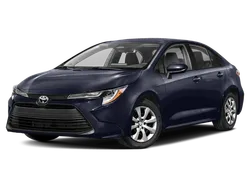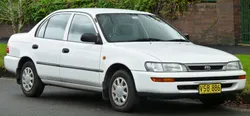

Toyota Corolla - Generation 7 - E100
Discover the Toyota Corolla, focusing on the generation 7 E100 model. This reliable car is popular in Portugal for its durability and fuel efficiency.
The Toyota Corolla has long been a subject of admiration among car enthusiasts and everyday drivers alike due to its reliability, efficiency, and practicality. The seventh generation, known as the E100, was pr...
Technical Specifications
Select Version
Dimensions
Engine
Driving
Others
History and Features
Mycarro AI
Apr 27, 2025
The Toyota Corolla has long been a subject of admiration among car enthusiasts and everyday drivers alike due to its reliability, efficiency, and practicality. The seventh generation, known as the E100, was produced from 1991 to 1997 and marked a pivotal point in the model's evolution. This generation managed to blend design aesthetics, advanced engineering, and notable features that would set the stage for subsequent iterations of the Corolla.
Design Evolution
When the E100 was unveiled, the design took a more modern approach compared to its predecessor. The seventh-generation Corolla showcased a rounded and aerodynamic silhouette, which was a departure from the boxier shapes that were more common in earlier models. The curved front end, sweeping lines along the body, and a redesigned rear helped make the vehicle more fuel-efficient and visually appealing. These changes were well-received and played an essential role in attracting a broader audience, including younger buyers who were looking for a stylish yet practical compact car.
Performance and Engine Options
Under the hood, the Toyota Corolla E100 offered a range of engine options tailored to meet diverse performance needs and fuel economy requirements. The standard engine was a 1.6-liter inline-four that generated around 105 horsepower. For those seeking a bit more power or a sportier driving experience, a 1.8-liter engine option was also available in certain markets. This engine garnered praise for its smooth operation and adaptability, allowing the Corolla to achieve impressive fuel economy figures, which was a central aspect of its appeal. The E100 was also the first generation of Corolla to offer a diesel engine option, further expanding its market reach.
Interior Comfort and Features
The interior of the E100 offered a significant upgrade in terms of design and comfort compared to earlier versions. It featured a user-friendly layout with improved ergonomics, making the driving experience more enjoyable. The quality of materials used inside the cabin improved significantly, and options for additional features such as air conditioning, power windows, and a stereo system enhanced overall comfort. The spaciousness of the interior made it a favorite among families and commuters alike, as it allowed for ample legroom and cargo space.
Safety Innovations
Safety was a top priority during the development of the E100, making it one of the safer compact cars available at the time. It was equipped with features such as improved crumple zones, reinforced passenger safety cages, and anti-lock braking systems (ABS) as optional on certain models. The introduction of these safety innovations not only enhanced occupant protection but also reassured parents who chose the Corolla as a family vehicle. This emphasis on safety aligned well with Toyota's commitment to producing reliable vehicles that prioritize the well-being of their drivers and passengers.
Global Reach
The E100 was not only aimed at the domestic Japanese market; it was exported to numerous countries around the globe. Manufacturing localization allowed for a range of models tailored to specific markets, which helped Toyota solidify its position as a leading player in the compact car segment. The Corolla quickly became a favorite in regions such as North America, Europe, and Asia. Its reputation for longevity, coupled with an efficient distribution network, ensured that it became a dominant force in the automotive industry during its production run.
Legacy and Impact
The Toyota Corolla Generation 7 (E100) set a high standard for future generations and significantly impacted the automotive landscape. Its combination of style, reliability, and practicality established a blueprint for what a compact car should be. Many of the design features and performance attributes introduced during this generation laid the groundwork for the success of subsequent Corollas.
In conclusion, the E100 was more than just a vehicle; it represented a significant evolution in the enduring legacy of the Toyota Corolla. Its influence can still be seen in modern iterations, reminding us of the importance of reliability, efficiency, and a user-centric design philosophy that continues to resonate with drivers around the world.
